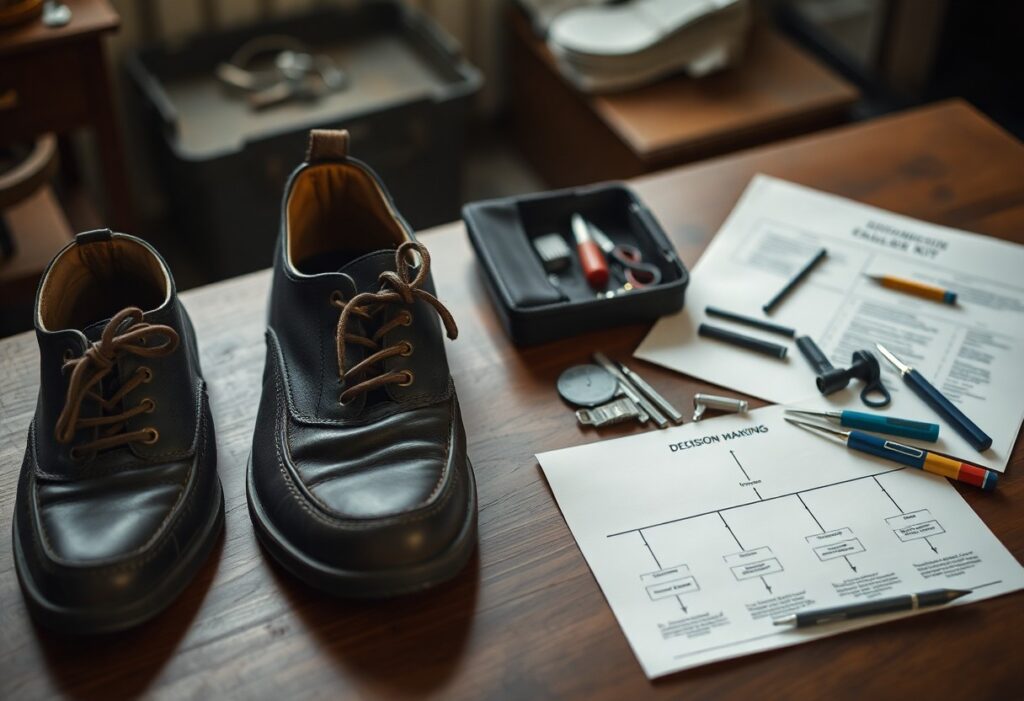
This comprehensive guide is designed to equip you with the essential knowledge needed to make informed decisions regarding the future of your footwear. When faced with worn-out shoes, the choice between repairing and replacing them can significantly impact your finances while also extending the lifespan of your beloved shoes. Consider critical factors such as the initial quality of your shoes, the severity of the damage, and the repair costs involved. For instance, if you possess high-quality leather shoes with issues like sole wear or heel damage, opting for repairs could be a more beneficial decision. On the other hand, if the upper leather is severely damaged or if there are multiple structural issues, a replacement might be warranted. Understanding these vital considerations will empower you to manage your footwear effectively and make financially sound choices.
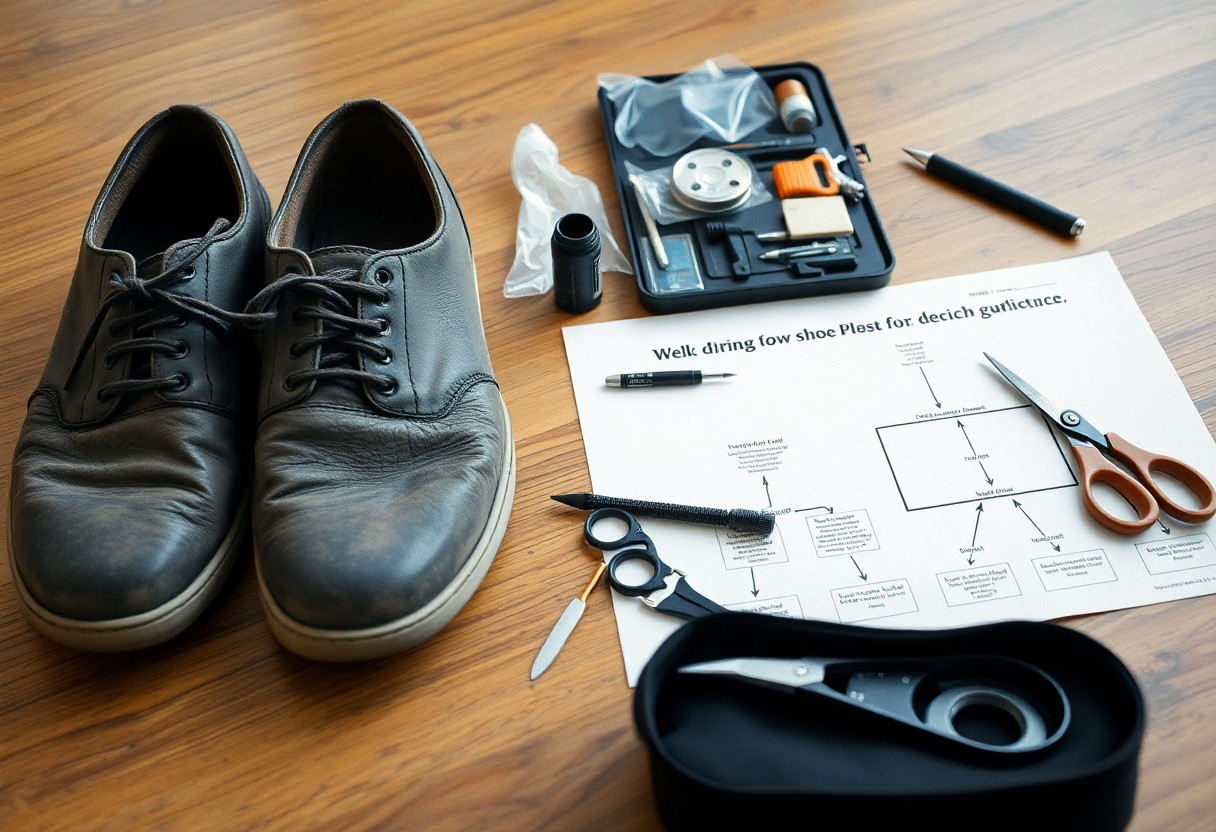
Identify and Understand Common Types of Shoe Damage for Better Choices
Before deciding whether to repair or replace your footwear, it is crucial to recognize the typical types of damage that can affect your cherished shoes. Shoes can suffer from deterioration in key areas such as soles, heels, uppers, and structural components. Being able to spot these issues early can greatly enhance your decision-making ability regarding necessary repairs and help keep your footwear in top condition.
| Damage Type | Repair Possibility |
| Sole Wear | Usually repairable |
| Heel Damage | Highly repairable |
| Upper Leather Cracks | Limited repair options |
| Structural Issues | Case-dependent |
| Cosmetic Damage | Mostly repairable |
Proactively Addressing Common Sole and Heel Issues for Extended Use
The soles of your shoes are often the first to show signs of wear, with heel deterioration being one of the most prevalent issues faced by shoe owners. It is crucial to pay immediate attention to your shoes as soon as you detect uneven wear patterns or noticeable wear on the edges of the heels. Addressing these concerns promptly not only helps prevent additional damage but also enhances the overall comfort of your footwear. Regular maintenance and timely repairs can significantly prolong the life of your shoes, maximizing your investment in quality footwear.
Recognizing Upper Leather Damage and Its Implications
For those who own leather shoes, encountering issues like creasing, cracking, and scratches is quite common. These problems often arise from regular wear and inadequate care. It is essential to assess the severity of the leather damage, as it can vary greatly. Some shoes may exhibit only superficial scratches that are relatively simple to fix, while others may have deeper cracks that complicate the repair process. Understanding how these issues affect both aesthetics and functionality will guide you in determining the best course of action for your footwear.
Understanding the Importance of Structural Damage in Your Shoes
Common structural issues found in shoes encompass separated soles, broken shanks, and damaged welts. The integrity of your shoes’ structure is critical to both their comfort and safety. Repairs related to structural elements typically require professional assistance. A skilled cobbler can evaluate whether the damage is repairable or if replacement is the more practical option. Staying aware of the structural condition of your shoes can help prevent accidents and ensure your footwear remains safe to wear.
Restoring Cosmetic Damage for Improved Aesthetic Appeal
Surface scuffs, fading color, and minor scratches are categorized as cosmetic damage. The good news is that with proper care and treatment, your shoes can often be revitalized. Cosmetic repairs are generally among the most cost-effective options available. Through professional cleaning and refinishing services, your shoes can regain their visual appeal, looking almost new again. Maintaining the aesthetic quality of your footwear not only enhances your overall look but also boosts your confidence while wearing them.
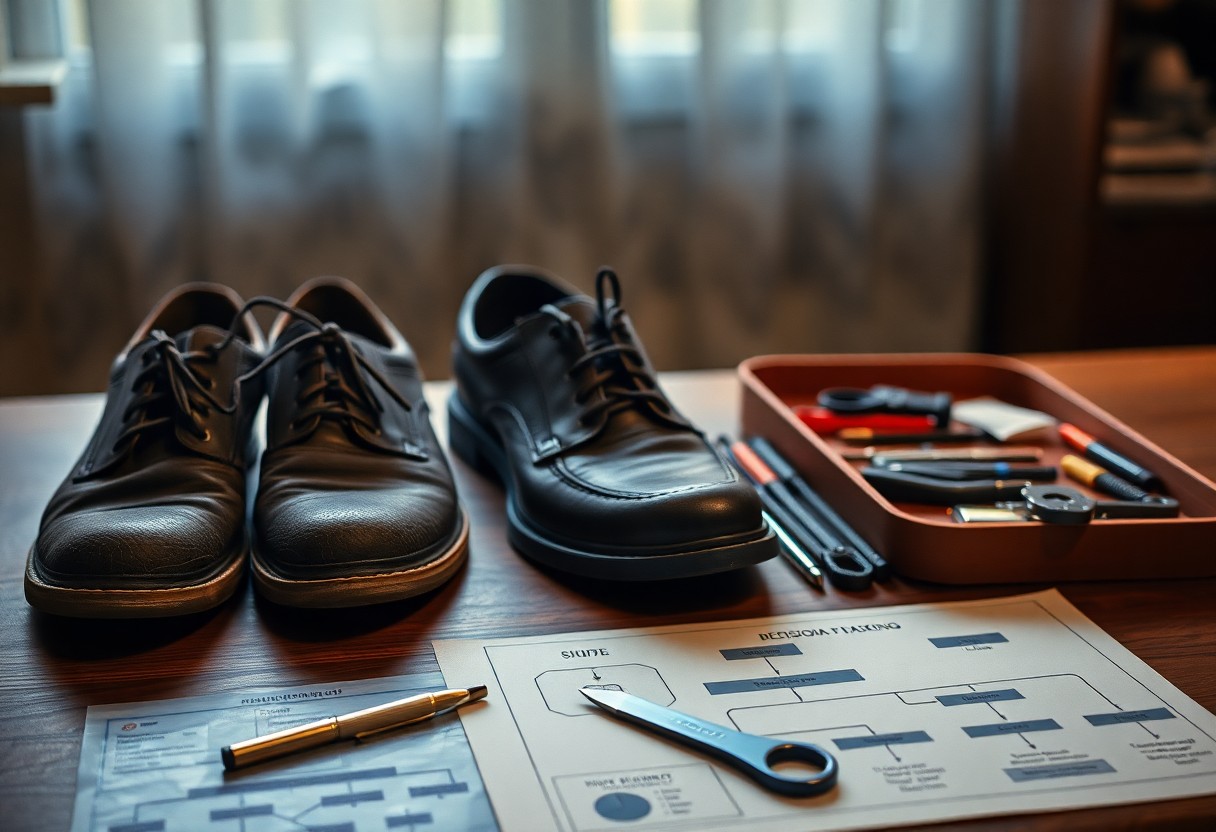
Key Considerations When Deciding Between Repairs or Replacement
Before making the decision to repair or replace your shoes, it is essential to evaluate several important factors. These considerations include the age and condition of the shoes, a comparison of repair costs against the cost of new shoes, the quality of materials, and any sentimental value attached to the footwear. Each decision should encompass practical evaluations alongside financial implications to ensure you achieve the best possible outcome.
- Overall condition assessment
- Cost comparison
- Material quality check
- Sentimental value evaluation
Assessing the Age and Overall Condition of Your Footwear
If your shoes are fairly new, say under two years old, and show minimal wear aside from some issues with the sole or heel, then repairs are often a worthwhile consideration. Carefully inspect the upper materials for signs of cracking, check the condition of the insoles, and assess the integrity of the stitching to ensure your footwear remains in good shape. A thorough evaluation will help you determine whether investing in repairs is justified based on the current condition of your shoes.
Cost Analysis: Weighing Repair Expenses Against New Shoe Purchases
| Basic Repairs | €15-60 |
| Major Repairs | €70-200 |
| New Quality Shoes | €200-500 |
As a general guideline, repair costs should ideally not exceed 50% of the price of new shoes for the option to be considered financially viable. This benchmark serves as a crucial reference when weighing your options and will help ensure you make the most economically sound decision.
| Heel Replacement | €15-30 |
| Half Sole Repair | €70-120 |
| Full Sole Repair | €130-200 |
| Heel Lining | €25-60 |
Evaluating Shoe Quality and Material Durability
The type of construction and the quality of materials used in your shoes are critical factors to consider when making your decision. Welted shoes crafted from full-grain leather are typically more amenable to repairs compared to cemented shoes made from synthetic materials. The ease of repairing a shoe is often closely tied to its construction method. Understanding this relationship can guide you in making more informed choices regarding repairs versus replacements.
High-quality welted shoes can usually withstand multiple repairs, while less expensive cemented constructions may not justify the time and expense involved in fixing them. Being aware of the various types of materials and construction methods will assist you in making informed decisions that can optimize the lifespan and functionality of your footwear.
Considering Sentimental Value in Your Repair Decision
Even shoes that have seen better days may be worth repairing if they hold special significance or are rare vintage finds that resonate emotionally with you. The comfort level, perfect fit, and emotional connection you have with the footwear can justify higher repair costs. While evaluating the practical aspects of your decision, do not underestimate the importance of personal values that can influence your final choice.
Determining the Optimal Times for Footwear Repairs
Your decision to repair shoes should be based on their overall condition and intrinsic value. If your footwear boasts quality leather uppers and has a solid construction, repairs can significantly extend their functional lifespan. It’s advisable to pursue repairs when damage is confined to specific areas, such as the soles or heels, while the overall structural integrity remains intact.
Identifying Repairable Conditions in Your Shoes
There are numerous fixable issues that indicate shoes are worth repairing, including worn soles, damaged heels, loose stitching, and minor leather scuffs. Your footwear is a good candidate for repair if the upper leather remains intact and the insole shows no signs of cracking. Basic repair costs typically range from $15-60, making them a financially sensible option for extending the life of your shoes.
Recognizing Cost-Effective Scenarios for Repairs
The ideal time to repair your shoes is when the cost of repair is less than 50% of the price of new shoes. Expensive leather footwear, particularly those crafted with welted constructions, are generally worth the investment in repairs, especially when basic resoling ($70-120) is significantly less than purchasing new high-quality shoes. Conditions that justify repairs include high-quality construction, minimal wear on the upper parts, and damage restricted to easily replaceable components. Ensure your shoes have intact insoles and uncracked upper leather to validate repair costs ranging from $25 for heel replacement to $200 for full sole repairs.
Understanding the Benefits of Professional Repairs
When repairs are conducted correctly, you can anticipate restored functionality and a considerably extended lifespan for your footwear. Well-executed repairs can provide several additional years of service, especially with quality resoling or heel replacement work. The durability of repairs can vary depending on the type: heel replacements may last anywhere from 6 months to 2 years, while resoled shoes can offer an additional 2-5 years of use with proper care. Your repaired shoes should maintain their original fit and support, ensuring comfort and optimal performance.
Recognizing When Purchasing New Footwear Is Necessary
It becomes essential to replace your shoes when the costs of repairs surpass 50% of the price of new shoes or when significant structural damage renders repairs impractical. Warning signs include severe cracks in the upper leather, compromised insoles, or multiple repair needs that arise simultaneously, indicating that it’s time to explore new options.
Identifying Conditions That Are Beyond Repair
Certain types of damage lie beyond the scope of repair, making it crucial to recognize these situations. Look out for deep cracks in multiple areas of the upper leather, severely damaged insoles, or widespread structural failures. When you encounter these issues, it is wise to begin seeking replacements as the cost and effort of repairs may not yield satisfactory outcomes.
Evaluating Financial Aspects of Repair Versus Replacement
Not all repairs are created equal from a financial standpoint. Basic repairs such as heel replacements (€15-30) and sole repairs (€70-120) can be economical choices for maintaining quality footwear. However, if multiple repairs are required at once, it may signal that it’s time to consider new shoes. Given that quality welted shoes typically range from €200-500, comparing repair costs to the original price is essential. When total repair costs exceed half the price of new shoes, purchasing new footwear is often the more financially sound decision.
Prioritizing Safety When Evaluating Footwear Condition
Worn-out shoes can significantly increase the risk of foot injuries and accidents. Indicators such as completely smooth soles, exposed steel toe caps, or compromised water resistance suggest that your shoes no longer provide adequate protection. Safety considerations should reflect your working environment; if you operate in hazardous conditions or require specific safety features, even minor structural damage can make your shoes unsafe for continued wear. It is vital not to compromise your safety by wearing damaged footwear.
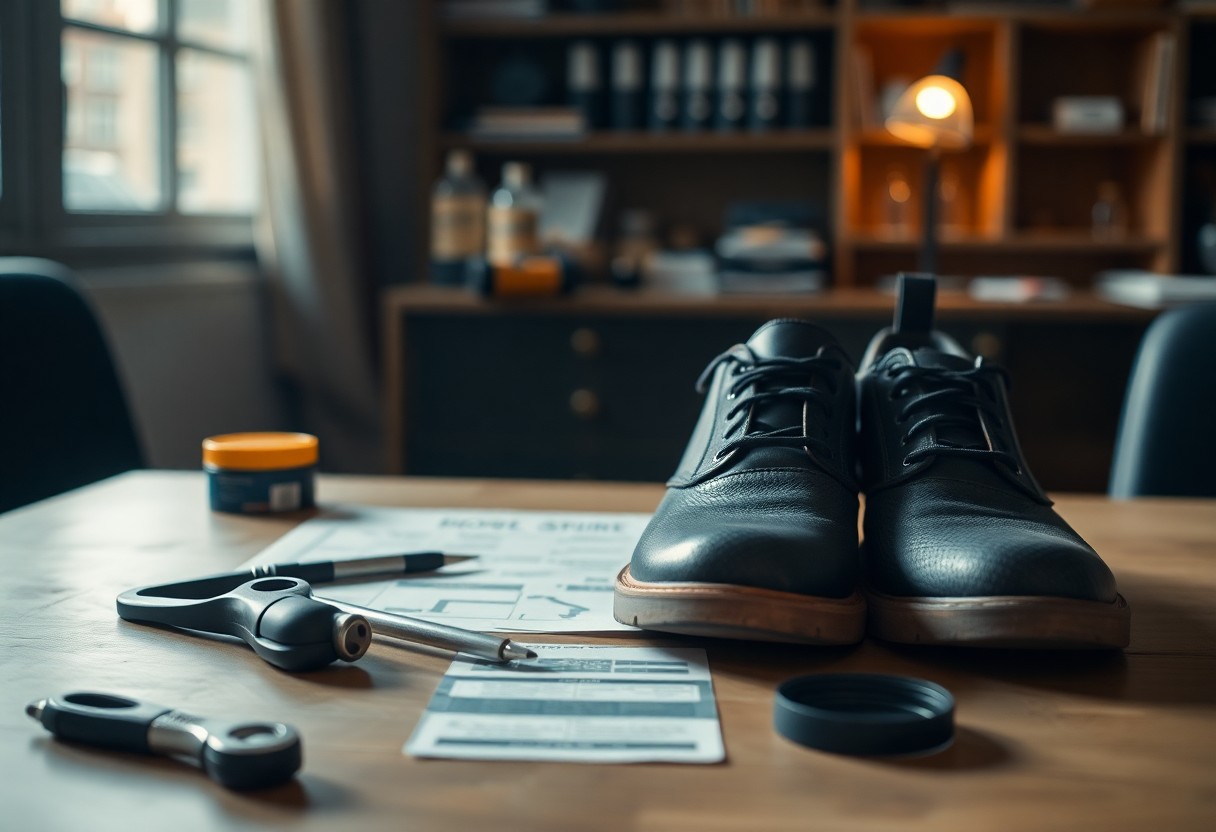
Follow This Detailed Step-by-Step Assessment Guide for Your Shoes
To streamline your shoe evaluation process and make it more efficient, adhere to this systematic approach to determine whether to repair or replace your footwear. This method will facilitate your decision-making and ensure that you address all necessary aspects of your footwear assessment.
| Repair Indicators | Replacement Indicators |
| Worn soles (no welt damage) | Cracked insoles |
| Heel wear (surface only) | Multiple upper cracks |
| Minor scratches | Severe structural damage |
Conducting a Thorough Damage Evaluation for Informed Choices
The first step in assessing your shoes is to examine them in adequate lighting. Carefully scrutinize the soles, heels, upper leather, and insoles for any signs of wear. A half sole replacement generally costs between €70-120, while a full sole repair can range from €130-200. By performing a detailed inspection, you can gather the necessary information to make a wise decision about your footwear.
- Sole integrity check
- Upper leather inspection
- Heel stability assessment
- Insole condition evaluation
Maximizing Professional Consultations for Optimal Repair Outcomes
Seeking an evaluation from a qualified professional can significantly enhance your ability to make informed decisions regarding the future of your shoes. Here are some essential tips to remember when consulting with a cobbler:
- Obtain multiple opinions if necessary
- Inquire about repair costs upfront
- Request timeline estimates for the repair process
- Compare repair estimates with new shoe prices
When visiting a cobbler, it is advisable to bring both shoes for a thorough assessment. Document any specific issues you’ve encountered and ask about warranty coverage for the proposed repairs. Understanding that a professional evaluation typically costs between €15-30 can help you budget effectively for this service.
Exploring Professional Repair Options for Your Footwear
To extend the life of your shoes, leveraging professional repair services can offer specialized solutions for various shoe-related issues. Local cobblers are well-equipped to handle everything from basic resoling to complex leather repairs, often at a fraction—30-50%—of the cost of purchasing new shoes. Ultimately, the decision to repair hinges on the quality of the shoe and the extent of the damage.
Discovering the Range of Shoe Repair Services Available
| Service | Average Cost |
|---|---|
| Heel Replacement | $15-30 |
| Full Sole Replacement | $50-70 |
| Leather Patching | $20-40 |
| Stitching Repair | $10-25 |
| Stretching | $15-20 |
- Resoling – Complete sole replacement
- Heel repair – Replacing worn heel tips
- Leather work – Patching and restoration
- Stretching – Adjusting shoes for a better fit
Finding a Qualified Cobbler to Meet Your Repair Needs
When searching for a reliable shoe repair professional, prioritize certified cobblers with positive customer reviews and a minimum of five years of experience. The best options usually include shoe repair shops equipped with specialized tools and a proven track record of handling your specific type of footwear.
You can verify a cobbler’s qualifications by checking their certification from the Shoe Service Institute of America, assessing the cleanliness of their workshop, and requesting to see examples of their past repair work. Local shoe retailers may also have partnerships with trusted repair professionals and can provide reliable recommendations tailored to your needs.
Making Informed Choices for Your Footwear Needs
With the insights provided, you are now better equipped to make informed decisions regarding whether to repair or replace your shoes. Generally, shoes are repairable when the damage is limited to the soles, heels, buckles, or surface scratches. Conversely, consider investing in new footwear when you discover cracks in the upper leather or damage to the insole, as these repairs typically incur higher costs than replacements and may not yield satisfactory results. The key lies in properly maintaining your shoes and promptly addressing necessary repairs. By carefully weighing repair costs against the overall value and condition of your footwear, you can extend its lifespan while also achieving significant long-term savings.
Frequently Asked Questions (FAQ) About Shoe Repairs
Q: How can I tell if my shoes are worth repairing or if I should buy new ones?
A: Assess several key factors: If your shoes are made of high-quality leather uppers without cracks and only require repairs to the soles or heels, then repairs are advisable. The total repair cost should ideally be less than 50% of the price of new shoes. Basic repairs like heel replacements ($20-35) and resoling ($70-120) are typically wise choices for quality footwear. However, if the upper leather shows cracks, the insole is damaged, or repairs exceed half the cost of new shoes, it may be time to consider purchasing new footwear.
Q: Which shoe repairs provide the best value for the cost?
A: The most cost-effective repairs include heel replacements ($20-35), heel lining repairs ($25-60), and simple regluing of separated components ($10-20). These repairs can significantly extend the lifespan of your shoes at a minimal expense. Half-sole replacements ($70-120) also offer good value for quality welted shoes. It’s essential not to postpone necessary repairs, as this may lead to more expensive damage that could ultimately require a complete shoe replacement.
Q: What types of shoe damage are generally irreparable?
A: Three primary forms of damage typically render repairs impractical: 1. Deep cracks in the upper leather, especially in areas prone to creasing 2. Structural cracks in the insole 3. Multiple significant damages requiring repair costs that exceed the price of new shoes. These issues compromise the fundamental structure of the shoe, and repairs often do not yield satisfactory results. In such instances, purchasing new shoes is usually the more viable alternative.
The Article Guide on deciding when to repair shoes versus buying new practical tips for making the right choice appeared first on My Shoes Finder
The Article Deciding to Repair Shoes or Buy New: Essential Tips Was Found On https://limitsofstrategy.com
The Article Repair Shoes or Buy New: Key Tips for Your Decision First Appeared ON
: https://ad4sc.com





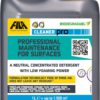



Comments are closed